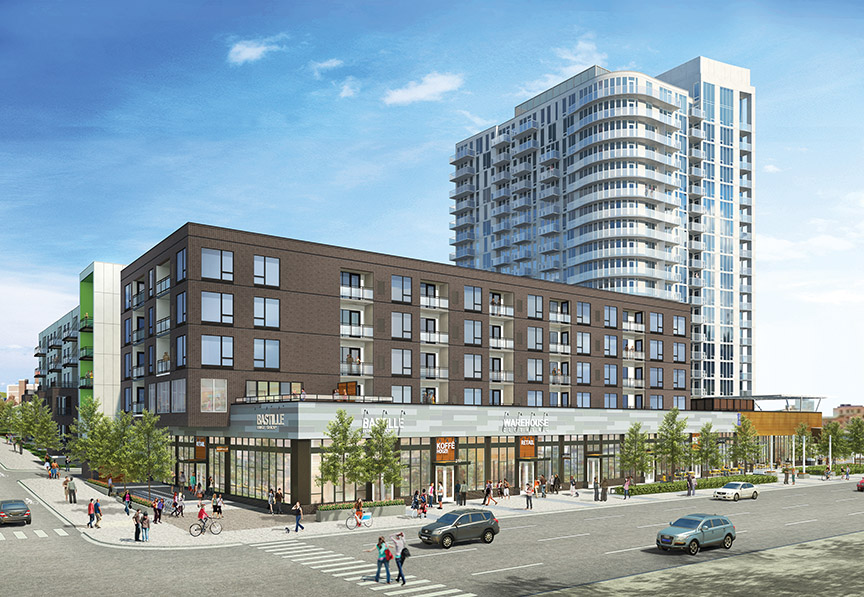Multifamily development was strong in 2017, very strong
By Todd Phillips, Minnesota Real Estate Journal
To recap the 2017 multi-family market, the Minnesota Real Estate Journal talked to three industry experts, Gina Dingman, President NAI Everest, Matt Mullins, Vice President at Maxfield Research, Jon Fletcher, Vice President of Development at Lennar. The final count for 2017 deliveries is expected to breach 4,500 units for the seven county metro, blowing past the previous high-water mark of 3,800 units set in 2014. According to Matt Mullins of Maxfield Research, “2018 looks just as strong. We are tracking 4,400 units under construction, or close to it, which should be completed in 2018.” Strong market fundamentals and an economy awash in capital seem to be driving continued development. “The metro is still seeing rent growth in most submarkets, some as high as 5%,” according to Gina Dingman of NAI Everest. Combined with a market vacancy of 2.7% and developers are paying attention. “As long as you have both rent growth and low vacancy, developers will continue to put up new projects.”
URBAN vs SUBURBAN
Lennar is one major player that isn’t locked in to either the suburban or urban model. They currently have projects under construction in Edina and Bloomington, as well as Minneapolis. According to Jon Fletcher, “We look for sites that are as close to amenities as possible. Walkability has become a big draw for our residents.” Proximity to retail defines a very large percentage of the new projects in the seven county metro, whether urban or suburban. “Folks want to be part of a community,” according to Fletcher. “There is only so much community you can fit inside a building; so the environment outside the building has become almost as important as what you put inside.” And Lennar is confident they have found and will continue to find sites that meet those criteria in both urban and suburban markets. “Land cost is becoming an issue, however.” adds Fletcher. As most developers have reported, the numbers still have to make sense. And with the market as hot as it is, there is a risk that land seller expectations have outpaced what a project can support. “It’s a potential issue in most submarkets,” adds Dingman. “Land Seller expectations have to be in-line with what a developer believes they can support with achievable rent projections.”
NEW PRODUCT vs REDEVELOPMENT
It is not just new product making an impact on the Minneapolis-St. Paul market; redevelopment is playing a major role as well. According to Dingman, “new projects are done on a slimmer margin than many of the redevelopment plays. Redevelopment often can have a bigger risk and thus more substantial rewards. Therefore, value-add developers are chasing redevelopment instead of building new.” Dingman further says she has seen value-add purchases top $150,000 per unit, and that’s before rehab costs. “When the project is complete, the developer is still delivering a class A project, even with the high per door cost they paid to acquire and redevelop the property, they are still below replacement cost.” FOLLOW THE MONEY In most real estate cycles, Minneapolis-St. Paul is overlooked by investment firms on the coasts, fly-over country. “Not only are we seeing money come in from the institutional investors on the coasts, we are getting substantial interest from direct foreign investors as well.” Dingman speculates that it is Minnesota’s strong economy and highly educated job market that has piqued those investors’ interest. The fact that MSP continues to be ranked a top five apartment market in most national reports seems to add to that as well. “I wouldn’t call it a herd mentality,” adds Dingman, “but strong fundamentals combined with a stable economy and workforce has certainly driven investors to Minnesota in large numbers.”
MEET THE DEVELOPERS
It is not just the big developers that making waves. Of course players like Doran Companies, Lennar, and Opus are busy doing mega-projects, but a number of other developers are busy as well. “CPM seems to be the leader by number of projects recently developed and in the ground. Collectively, all their 25 to 75 unit projects put them right up there with developers like Doran,” according to Mullins. “But it is definitely not any one developer or small group of developers. Development is currently spread across dozens of firms.”
WHEN WILL IT ALL END?
Dingman, Mullins and Fletcher all agree that growth looks good in the near term. With other metropolitan areas putting up 15,000 or more units in a year, Minnesota still looks constrained in comparison. “There are substantial barriers to entry in this market,” reports Dingman, “and that should keep development at a disciplined pace.” Unanimous concern about rising construction costs is also a mitigating factor. When you have rising land costs along with rising construction costs, it tightens the market for new development opportunities. Contractors report that nearly every line item in the construction budget is poised to go up in 2018. Some line items, like drywall, may go up double digits. Lennar is using creative strategies like exposed concrete ceilings and columns to reduce the need for drywall in projects. “With labor and materials headed down south to repair hurricane damage, construction costs are certainly a concern for 2018,” adds Fletcher. Only time will tell where 2018 will end, but all signs point forward for now.


